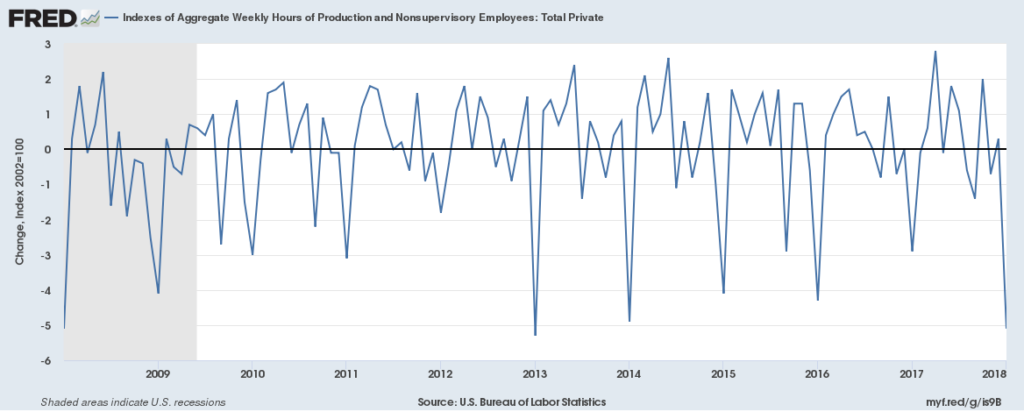We are back to “bad-news-is-good-news” and “good-news-is-great-news”
This week the markets shrugged off last week’s fears and went back to the slow and steady melt up, despite economic news that looked likely to once again rock the boat. By Thursday’s close, the S&P 500 had gained 5.8% from the prior Friday’s open, putting it and the rest of the major market indices back in the green for 2018. While next week will be a lite one on the economic data side, it will contain a few data pieces that we’ll be watching to gauge the vector and velocity of the global economy and inflation. Those results will tell us if we’re in for more weeks like this one or the prior one when it comes to the stock market.
Now let’s recap this week’s happenings and share my observations on it all…
Monday the S&P 500 soared 1.4% in the first half hour of trading only to then drop 1.3% from that high, then back up again to close up 1.4%. Tuesday and Wednesday were both basically days of further upward movement for the market. Thursday there was a slight wobble at the open — falling -0.3% in the second hour of trading — but then moved back up again to close up 1.2%. Having briefly dipped below its 200-day moving average last week, the S&P 500 closed Thursday all the way back up above its 50-day moving average and down just 4.9% from the January 26 all-time high, retracing roughly half of the decline from the January 26th peak.
Investors appear to still be rather skeptical when we look at fund flows. For the 8 days through Tuesday, equity ETFs saw the largest outflows of the past 5 years when converted to a monthly rate. Then again… Monday inflows were the largest year-to-date so perhaps after the Xanax and Zantac kicked in over the weekend, folks were feeling better. Perhaps some of the concerns are coming from the record high 24% of investors surveyed in the BofA Merrill Lunch Global Fund Manager Survey who think corporate balance sheets are overleveraged – problematic with rates rising as bonds need to be rolled over at a higher rate, leading to higher interest costs that weigh on earnings. That brings us to fixed income ETFs, which are still not feeling the love, having seen positive inflow days only 8 times this year as of Tuesday and have hit new cumulative outflow lows.
Looking at sector performance, since the opening on Friday 9th, the technology sector has gained an incredible 8.5% and financials rose 6.9% and we’ve seen a sharp rebound in the Connected Society and Disruptive Technologies positions on the Tematica Investing Select List. The weakest performing sector has been energy, which gained a comparatively weak 2.4%, and isn’t surprising given the continued fall-off in oil prices as more US capacity comes on stream.
Here’s the thing, technology is still 2.8% below its all-time high, while financials are 4.5% below their highs, whilst energy is 12.5% below its all-time high – again the weakest sector in terms of recovery. The performance in financials has been related to the changes in the yield curve – something I’ve talked about on our Cocktail Investing Podcast. The decline in the spread between the 10-year and the 2-year Treasury bond since December 2016 sharply reversed course back in early January and has continued to widen. The spread between the 30-year and 5-year Treasury bond yield had been declining since November 2013 has given signs of possibly starting to widen as of the beginning of the month, but nothing definitive yet. Financials perform better with wider spreads given that they borrow short and lend long, so the wider the spread, the greater the potential profit margin.
On the economic front this week we saw a meaningful increase in consumer credit, wage growth that was weaker than the headlines indicated, CPI and PPI numbers that gave further support to a Federal Reserve that is looking increasingly more hawkish and retail sales that came in below expectations with the biggest drop in nearly a year. That’s the quick summary now for the details and my observations:
In the fourth quarter consumer debt, (excluding mortgages and other home loans), increased 5.5% year-over-year to a record high $3.8 trillion. Non-housing debts also hit a record high of 29% of the overall debt load. Roughly 5.8% of disposable income is going to keep households current on their nonmortgage debt, which is the highest percentage since the end of 2008. For context, the lowest percentage reached was 4.9% in 2012. This is a potentially worrisome sign as this type of debt is more sensitive to rising interest rates. It is worth noting that the average repayment period for new car loans has hit an all-time high of 69 months as of Q3 2017, according to data from Experian. Personal loans to consumers during 1H 2017 were 7.8% higher than 2016.
The dangers here become apparent when we look at the Real Earnings report from the Bureau of Labor Statistics, which was also released this week, and showed that for the roughly 82% of workers in the Production and Nonsupervisory category real average hourly earnings have fallen in 5 of the past 6 months. Year-over-year their average weekly earnings have grown a meager 0.2% – further support for our Cash-Strapped Consumer investing theme. You can read more about that here. Rising credit card balances combined with income that for many people has been basically unchanged in a year is a coming headwind for consumer spending and the economy even before we factor in three to maybe four Fed rate hikes this year. As for all that talk of the economy heating up, the aggregate weekly hours for this group fell dramatically in January as the chart below shows.
Aggregate Weekly Hours of Production and Nonsupervisory Employees

We are cognizant that this decline could be misleading due to the exceptionally cold weather for parts of the country in January and one month certainly doesn’t make a trend, but this is an area we will be watching in the coming months.
This week also saw inflation data that is cause for concern with the headline Consumer Price Index rising more than expected, which you can read more about here. Core CPI is now rising at the fastest 3-month pace since 2011 and the fastest six-month pace since 2008, but year-over-year core CPI is still below 2% and is little changed compared to the last few months. Taking a step back we can also see that during the summer of 2017, the 3 and 6-month rates were at the lowest levels since the last recession, so base effects are making the increase look outsized. There has been some talk about the 1.7% increase in apparel prices, which was the largest since 1990. Again, we suspect that the fact that Floridians had to go buy parkas played a role here and in the bigger picture, and the reality is that apparel prices have fallen in 3 of the past 4 months and declined or were flat in 5 of the last 7 months. As we said above, one month does not make a trend people!
The 3-month annualized median CPI is up nearly 3.2% while the 6-month annualized is up 3% and year-over-year median CPI is up 2.4%, indicating that inflation overall is on the rise. We believe that this means the Federal Reserve’s plan to hike 3 times in 2018 is (at least as of now) essentially a done deal with the probability of a fourth hike rising. The Producer Price Index came out after CPI and also pointed towards inflationary pressures.
Thursday’s report on retail sales reasonably should have given the market at least some pause, but we are back to bad-news-is-good-news and good-news-is-great-news. The Commerce Department reported that retail sales in January fell -0.3%, the biggest decline since February 2017 versus expectations for a 0.2% increase and to really rub it in, December was revised down to unchanged from a gain of 0.4%. The market ignored the disappointing numbers and kept moving on up. From our perspective, nonstore retail sales – code words for digital commerce – rose 10% year on year, still taking consumer wallet share and boding very well for the thematic investing poster child better known as Amazon (AMZN).
The bottom line for the week is equities appear to have shrugged off the concerns from earlier in the month, 3-4 Fed hikes are increasingly likely and wage growth for much of the country remains stubbornly elusive despite the tightening labor market. We believe we have a decent grasp on what is behind the wage conundrum, but that is a topic for another day. As for what to expect from the markets in the coming weeks, we suspect that we are not out of the woods and that another retest of the recent lows is likely before moving on to make new highs.
Longer term we are in store for a fascinating battle between the impact of Fed tightening and fiscal stimulus (tax reforms and increased spending) on the economy and portfolio returns. Driving with one foot on the accelerator and one on the brakes comes to mind. The coming months and year are likely to be more challenging for investors than 2017, which is all the more reason to have solid investment strategies based on long-term themes.
With U.S. equity markets closed on Monday in observance of President’s Day, the weekly Monday Morning Kickoff penned by Tematica’s Chief Investment Officer, Chris Versace, will not be published. While that may disappoint more than a few folks, Chris and I will have no shortage of commentary next week due in part to the monthly Flash PMI data to be published by IHS Markit. While we will dig into those reports to gauge the velocity of the economy, we expect the comments on input prices will be of keen focus following the January inflation reports we received this week.
Enjoy the long weekend and be sure to look for our comments at TematicaResearch.com next week.!

